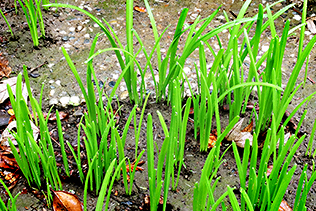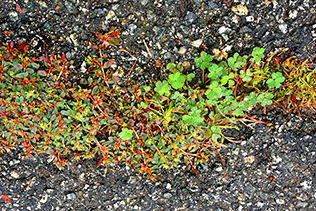"Many things grow in the garden that were never sown there."
– Thomas Fuller, Gnomologia, 1732
10/27/16:
One of the advantages of a container garden (versus planting directly into the soil of a yard) is not having to deal with a "weed bank" of unwanted wild plants that lurk underground as seeds and small bulbs, waiting for the right combination of sun and moisture to sprout and choke out my vegetables and flowers. As long as I keep the soil in my pots clean of unknown seeds, and I pull up any bits of stray grass or the occasional dandelion, I can avoid weeding for the majority of my plantings. The lawn and driveway are another matter, however. So many non-grass plants have popped up in the lawn over the years, and cracks in the asphalt pavement become narrow crooked rows of assorted leafy things, most of which are difficult to dig up entirely. It gets worse when I inadvertently water the pavement, attempting to reach all my pots with the hose, although I've gotten better over the years at controlling where the water goes.
From the reading I've been doing about gardening in the past 2 years, I have come to recognize some of the weeds. But wanting to properly identify everything, and to figure out which wild plants are considered edible, or can produce attractive flowers, I spent time this week in deeper research.
Clicking on the small images below will bring up a larger version.
 Wild leeks start up every fall.
Wild leeks start up every fall.
 Clover, crabgrass & spurge.
Clover, crabgrass & spurge.
 Selfheal.
Selfheal.
Unattractive weeds that have appeared in my yard include dandelions, hawkweed, bristly oxtongue, broadleaf plantain, cheatgrass, speedwell, curly dock, groundsel, lamb's quarters, prickly lettuce, spurge, shepherd's purse, crabgrass, sow thistle, stinging nettle, black medic, and mallow. I suppose I could call the ones I don't mind, or even appreciate, "wildlings" or "volunteers" instead of weeds: wild leeks, Bermuda buttercups (oxalis), scarlet pimpernel, clover, and selfheal. It was good to learn that the oxalis, selfheal, lamb's quarters, and chickweed are edible. Dandelions are as well, but I've tasted both leaves and buds and don't like the flavor.
These sites were particularly helpful with identification: Preen and UC Agriculture's Weed Gallery.
As for weed control, I've tried sprays and granular treatments (non-chemical ones only during the past 3 years). I haven't found anything very effective that doesn't smell bad or kill off desirable plants also. Pouring boiling water into cracks in the pavement didn't work that well; perhaps the water had cooled down too much by the time I got it outside: only the tops of weeds were damaged, not the roots. Spreading a mulch around my plants that might prevent weed seeds from germinating works okay in my containers, but isn't a strategy for the lawn or pavement. So I tend to pull the largest, most noticeable weeds while I'm out watering the grass, and just let the rest go until the landlady is about to visit.
In other current gardening endeavors, I planted morning glory seeds recently and there are now 10-15 healthy-looking sprouts. These are my favorite flower, but I've had little success at getting them to grow to maturity and bloom. The Royal Blue Ensign bush variety, unfortunately an annual, did okay this spring/early summer but has now died out. Morning glories flourish so easily in other yards. They can choke out nearby plants and are considered a weed sometimes. Perhaps one day I too will have clusters of vines many feet long, covered in heart-shaped leaves and gorgeous blue flowers, but I'll settle for a few containers of modest-sized plants to brighten up selected corners of my garden.







